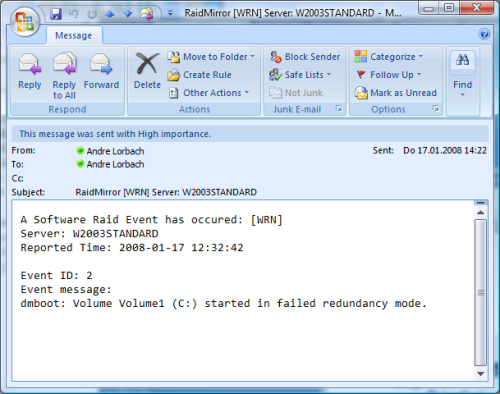
As we said earlier, that we’re using CentOS 6.5 Final release for this raid setup, but the same steps can be followed for RAID setup in any Linux-based distribution. Step 1: Installing mdadm and Verify Drivesġ.
#OPEN SOURCE RAID MONITOR SOFTWARE#
This article is Part 4 of a 9-tutorial RAID series, here we are going to set up a software RAID 5 with distributed parity in Linux systems or servers using three 20GB disks named /dev/sdb, /dev/sdc, and /dev/sdd. My Server Setup Operating System :ĜentOS 6.5 Final Setting up RAID 1 (Mirroring) in Linux – Part 3.Creating RAID 0 (Stripe) in Linux – Part 2.Basic Concepts of RAID in Linux – Part 1.

By default there is no configuration file is available for RAID, we must save the configuration file after creating and configuring the RAID setup in a separate file called nf.īefore moving further, I suggest you go through the following articles for understanding the basics of RAID in Linux. Mdadm is a package that allows us to configure and manage RAID devices in Linux. Here, we are using software RAID and the ‘ mdadm‘ package to create a raid. Minimum 3 hard drives are required to create Raid 5, but you can add more disks, only if you have a dedicated hardware raid controller with multi ports.
#OPEN SOURCE RAID MONITOR SERIAL#
These areas can be removed to reveal the data hidden within these areas.ĭiskCheckup also displays device information, such as the drive geometry, serial number, model number, media rotation rate, and supported features. The HPA/DCO are hidden areas of the hard disk that contain data not accessible by the user. The results of these tests are displayed in DiskCheckup.ĭiskCheckup can detect and set the sizes of the Host Protected Area (HPA) and Device Configuration Overlay (DCO).

There are two main self-test routines: Short Test and Extended Test. DiskCheckup monitors these changes over a long period and predict the date (if available) of the Threshold Exceed Condition (TEC), which is displayed on the main window.ĭiskCheckup can also execute built-in Disk Self-Test (DST) routines implemented by the vendor to detect drive failures. Note that SMART attributes change slowly over time and are helpful attempts to diagnose the life span of a particular drive. If an attribute drops below its threshold, the drive cannot guarantee that it will be able to meet its specifications in the future. SMART monitors elements of possible long term drive failure, such as 'Spin Up Time', the number of start/stops, the number of hours powered on and the hard disk temperature.ĭiskCheckup displays the current values of the SMART attributes, along with the Threshold value for that attribute. If SMART is enabled on a hard disk, the system administrator can receive analytical information from the hard drive to determine a possible future failure of the hard drive.

SMART (Self-Monitoring Analysis and Reporting Technology) is a feature on a computer's hard disk for providing various monitoring indicators of disk reliability. PassMark DiskCheckup™ allows the user to monitor the SMART attributes of a particular hard disk drive.


 0 kommentar(er)
0 kommentar(er)
